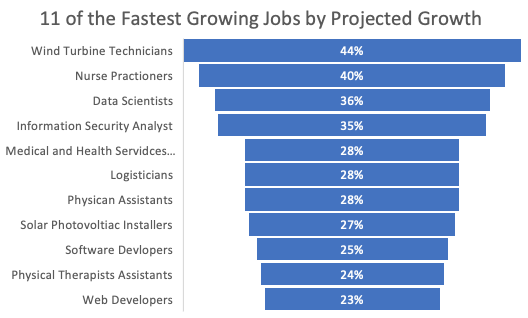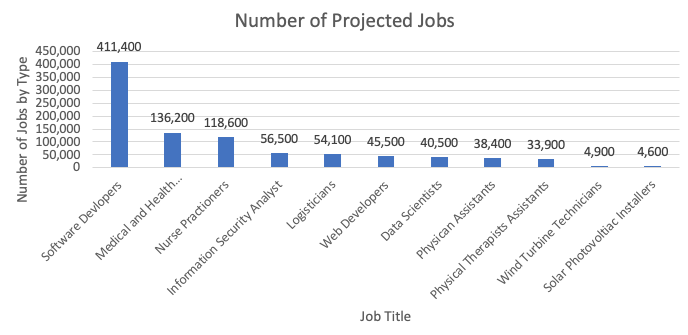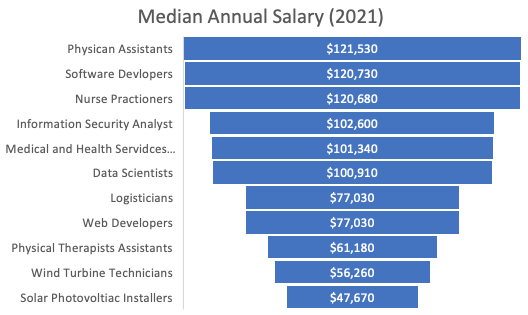While the job market has cooled off some, there is still a lot of opportunity out there. One way to take advantage of it is to know which job fields are poised to have the biggest gains in the next 10 years.
Jobs with Projected High Demand
If you are getting out of the military in the next few years, this information can help you prepare now, so that you know which fields may be the best for you once you are transitioned out. Here are eleven jobs that have promising futures during the next decade.
Number of Projected Jobs
As shown in descending order, we see that four of the jobs are in the healthcare industry, three in the IT/Computer field, two in alternative energy and one each in science and logistics. And while the percentages when compared to the job market overall are great, how does percentage translate into number of jobs? That date is below.
Even though a projected job field percentage can be high, if the number of jobs in that field are small to begin with, the number of potential jobs is usually small too. Of course as we can see by the chart above, the top three leaders are:
- Software Developers
- Medical and Health Services Managers
- Nurse Practitioners
One interesting fact noted in the chart is the fact that generally speaking a Physician’s Assistant (PA) and Nurse Practitioner (NP) do the same work and are paid about the same, their projected demands are much different – 3.5 times greater for NPs than for PAs or 118,600 vs 33,900, respectively.
If you are in the military medical field and want to stay in that field after getting out, either of these two jobs would be great choices to have on the outside.
Median Salary
Of course with any job pay is also a consideration; all but one of the jobs pays a median annual salary of at least $50,000. The one exception is the Solar Photovoltaic Installer which pays $47,960.
Education Requirements
The last piece of this puzzle that you must know to make an informed decision is how much education does it take to enter each of these fields.
Healthcare
- Nurse Practitioner – Master’s degree in one of the ARPN roles program
- Physician’s Assistant – Master’s degree from an accredited PA program
- Medical and Health Services Manager – At least a bachelor’s degree with a master’s degree becoming more common
- Physical Therapists Assistant – High school diploma and an associate degree from an accredited program plus on-the-job training.
IT/Computer
- Information Security Analyst – Bachelor’s degree in a computer science field and work-related experience
- Software Developer – At least a bachelor’s degree in computer and information technology.
- Web Developer -Educational requirements range from having a high school diploma and certification to having a bachelor’s degree
Alternative Energy
- Wind Turbine Service Technician – High school diploma and usually technical school and on-the-job (OJT) training that can last up to a year.
- Solar Photovoltaic Installer – High school diploma and usually technical school and on-the-job (OJT) training that can last up to a year.
Miscellaneous
- Data Scientist – At least a bachelor’s degree in mathematics, statistics, computer science or a related field.
- Logistician – At least an associate degree with a bachelor’s degree becoming more common.
For many of these jobs, there is a direct correlation to jobs in the military and if you happened to be in one of these jobs, much of that education, training and experience will transfer over as college credits. If further education is required to qualify for a job, this not only shortens up the time it takes to meet the education requirements, but it also uses up fewer GI Bill entitlements so that you could further your education and chances for promotion to higher-graded jobs sometime in the future.
[Source for all data: Bureau of Labor Statistics]







